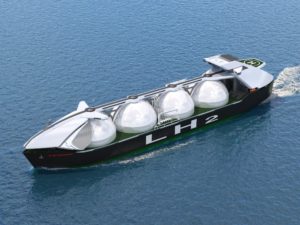with world’s highest carrying capacity
07 May 2021 – Leading Classification Society ClassNK has issued an Approval in Principle (AiP) to Kawasaki Heavy Industries, Ltd for the design of a cargo containment system (CCS) of the world’s largest capacity (40,000 m3 class per tank) developed for use on a large liquefied hydrogen carrier.
Hydrogen is expected to be used as a clean energy source to realize a decarbonized society as its burning does not emit CO2. To contribute to the maritime transportation of hydrogen, which is anticipated to expand its use worldwide, in 2017 ClassNK published the “Guidelines for Liquefied Hydrogen Carriers” describing the safety requirements for liquified hydrogen carriers based on IMO’s Interim Recommendations for Carriage of Liquefied Hydrogen in Bulk. Besides, ClassNK has engaged in the classification survey during construction of a pioneering liquified hydrogen carrier, SUISO FRONTIER*1, of a 1,250m3 carrying capacity built by Kawasaki according to its rules and guidelines.
Having received an application from Kawasaki, ClassNK carried out the design review of the newly developed CCS*2 for a hydrogen liquified carrier based on its Part N of Rules for the Survey and Construction of Steel Ships incorporating the IGC Code, and its guidelines incorporating the IMO’s interim recommendations. In addition, a comprehensive safety assessment of the CCS was conducted based on the HAZID risk assessment results, which has led to the issuance of the AiP.
The main features of the CCS announced by Kawasaki are as follows:
- Enables transportation of cryogenic liquefied hydrogen in large amounts thanks to tank capacity on par with tanks used on large liquefied natural gas (LNG) carriers
- Utilizes an independent, self-supporting design with a structure capable of responding flexibly to thermal contraction that occurs when loading cryogenic liquefied hydrogen
- Features a newly developed, high-performance heat insulation system that mitigates boil-off gas (BOG) which occurs in response to heat ingress
- Designed to effectively utilize BOG as fuel to power the ship, thus contributing to reduced CO2 emissions from liquefied hydrogen transport operations

Large liquefied hydrogen carrier (cargo carrying capacity: 40,000 m3 x 4 tanks): Courtesy of Kawasaki
*1 Constructed by Kawasaki as a member of the CO2-free Hydrogen Energy Supply-chain Technology Research Association (HySTRA; website: http://www.hystra.or.jp/), as part of the Demonstration Project for Establishment of Mass Hydrogen Marine Transportation Supply Chain Derived from Unused Brown Coal by the New Energy and Industrial Technology Development Organization (NEDO).
*2 Developed by NEDO Technology Development Project for Building a Hydrogen-based Society / Technology Development Project for Large-Scale Utilization of Hydrogen / Project for Enlargement of Liquefied Hydrogen Cargo Tank Facilities and Development of Unloading Terminal Equipment
For more information on this topic please contact:
ClassNK Public Relations Team
Tel: +81-3-5226-2047
E-mail: eod@classnk.or.jp
